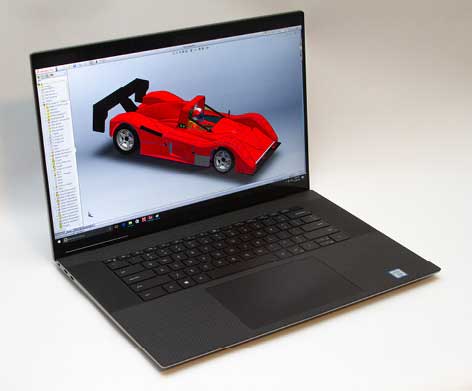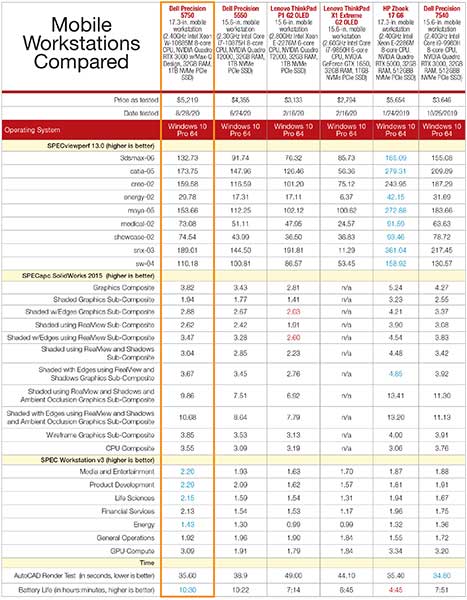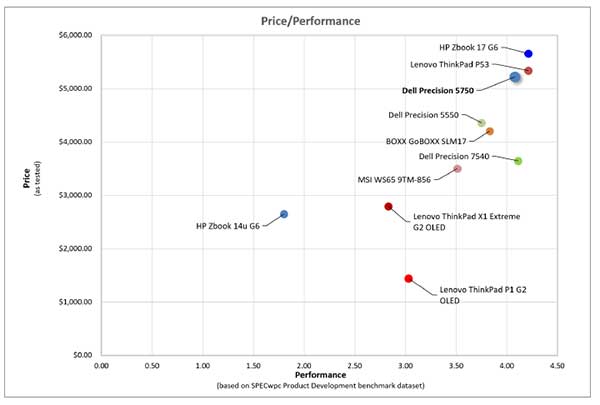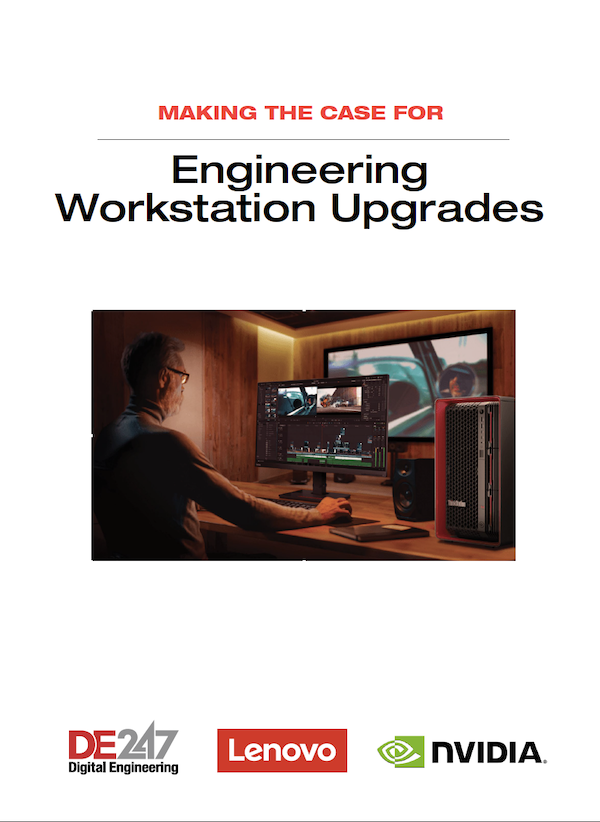Dell Precision 5750: The Smallest 17-in. Workstation
Dell’s new Precision mobile system is small but pricey.

The new 17.3-in. Dell Precision 5750 packs power and a gorgeous display into a thin, lightweight chassis with minimal ports. Image courtesy of Dell.
Latest News
November 2, 2020
After recently reviewing the Dell Precision 5550 (DE, September 2020), the newest 15-in. addition to the company’s mobile workstation offerings, Dell sent us its larger sibling. Dell touts the Precision 5750 as “the world’s smallest and most intelligent 17-in. workstation,” a claim that we quickly put to the test.
Like the Precision 5550, the Precision 5750 comes housed in a silver-colored case, and is less than an inch thick. The system measures at just 14.75×9.54×0.87 in. (W×D×H) and weighs a mere 5.5 lbs., plus 0.98 lb. for its 130-watt power supply (5.63×2.63×0.87 in.).
No Numeric Keypad
Lifting the lid reveals a beautiful 17.3-in. display with a 16:10 aspect ratio surrounded by Dell’s new Infinity Edge bezel. This feature, also found on the 15-in. Precision 5550, measures just over 1/8-in., resulting in a near borderless screen. Yet, Dell still managed to place an RGB-infrared webcam centered in the top edge of the bezel, flanked by a pair of infrared emitters, an ambient-light sensor and a camera-status light, while a pair of microphones are located on the top edge of the case. As was true for the Precision 5550, there is no webcam privacy shutter.
The Dell Precision 5750 incorporates the same 79-key backlit keyboard as its smaller sibling. This keyboard provides a very good feel and ample 1.3-mm key travel and includes an additional key in its upper-right corner that serves as the power button.
The keyboard is flanked by a pair of top-firing stereo speakers, with slots along the bottom edge on either side of the case for left and right woofers. Although the speakers provide very good sound, the configuration fills the available space, leaving no room for a separate numeric keypad, a curious omission on a 17-in. system.
A large (5.94×3.56 in.) gesture-enabled touchpad is centered in the palm rest below the keyboard. This is identical to the Precision 5550, and like that system, it lacks any dedicated buttons but recognizes the difference between left- and right-clicks. Only the Caps Lock key includes an indicator light. An LED diagnostics light is located on the front edge of the case, centered below the touchpad.
Proximity Sensor Concerns
Although the size of the Dell Precision 5750 is a welcome change from bulky 17-in. systems, the thin chassis leaves limited space for external ports. The left side provides a wedge-shaped security lock slot and a pair of USB 3.2 Gen 2 Type-C ports. The right side hosts two additional USB 3.2 Type-C ports, an SD-card reader and a 3.5-mm audio port.
All four USB Type-C ports are charging ports and also support Thunderbolt 3 and DisplayPort 1.4. One of the Type-C ports must be used to connect the external power supply. There are no other ports.
Like the Precision 5550, the Dell Precision 5750 comes with a small adapter that, when plugged into a USB Type-C port, provides a single HDMI port and a single USB Type-A port. But it’s still our opinion that modern systems require a minimum of two USB Type-A ports, one for a mouse and one for an external hard drive or thumb drive. Some users might also want an RJ-45 jack to connect to a gigabit network.
Dell sells several adapters, including a USB-C mobile adapter ($70) that provides six ports (USB-A, USB-C, HDMI, VGA, DisplayPort and RJ-45) and a Thunderbolt Dock ($275) that houses 11 ports (three USB-A, two USB-C, HDMI, two DisplayPorts, two audio combo jacks and a power connector). There are also a number of third-party adapters that would work, or you could purchase several USB Type-C to Type-A adapters. Either way, you may want to factor this into your purchase.
More troubling, however, was a feature we did not initially know existed. The Dell Precision 5750 includes a proximity sensor, located just to the left of the webcam. When you raise the lid, the system immediately boots up; there is no need to touch the power button. But we were puzzled by the fact that during our initial testing, the screen would turn off and the system would hibernate after 1 minute, despite the fact that we had changed the power settings to one in which this should never happen.

It turns out that the latest version of the Dell Optimizer software—designed to dynamically optimize the system’s performance using artificial intelligence and machine learning—is set to do this by default, to enhance privacy when you walk away from your desk. However, there was nothing accompanying the system to let a new user know that this feature existed. An email to our contact at Dell provided the solution before we resorted to calling tech support. We feel that Dell should either include some sort of hard-copy document prominently explaining this or not have this feature automatically enabled.
Lots of Options
Although external connections are limited, Dell offers quite a few internal options. With a starting price of $2,399, the base configuration includes an Intel Core i5-10400H 2.6GHz 4-core CPU with integrated Intel HD Graphics 630, a 1920×1200 display, 8GB of DDR4 2933MHz RAM, a 256GB M.2 PCIe NVMe Class 35 solid-state drive (SSD), a 3-cell 56Whr lithium-ion battery and a 90-watt power supply, essentially identical to the base model of the Precision 5550. But again, that is just the starting point.
Dell offers a choice of seven different Intel processors. In addition to the base 4-core i5 CPU, you can opt for one of two Intel Core i7 6-core variants (the 2.6GHz i7-10750H or 2.7GHz i7-10850H), one of two 8-core i7s (the 2.3GHz i7-10875H or 2.4GHz i7-10885H), or one of two Intel Xeon CPUs (the 6-core W-10855M or 8-core W-10885M).
All of these Comet Lake CPUs offer increased core counts and faster clock speeds than the previous generation, but the highest numbers are only achievable with what Intel calls its Thermal Velocity Boost. This means the additional speed is only available periodically when the processor is operating below its maximum temperature.
Our evaluation unit came with the Intel Xeon W-10885M CPU, an 8-core processor released in the spring of 2020. This CPU features a 2.4GHz base frequency, 5.3GHz max turbo, 16MB of Smart Cache and a thermal design power rating of 45 watts adding $448 to the base price.
In addition to the integrated Intel graphics, Dell offers the Precision 5750 with a choice of two NVIDIA discrete graphics processing units (GPU): the Quadro T2000 ($266) or the Quadro RTX 3000 with Max-Q ($426), which was included in the system we received. This GPU incorporates 6GB of GDDR6 memory, 1920 compute unified device architecture cores, 30 RT cores and 240 Tensor cores.

Based on NVIDIA’s Turing architecture, the RTX 3000 has a 192-bit interface, enabling it to deliver a bandwidth of 288.05GB/second while consuming 80 watts. The discrete graphics card requires a larger (130-watt) power supply, adding $17.
Dell also offers a choice of two displays. Our evaluation unit included the same gorgeous 3840×2400 touch-enabled display as the one in the Precision 5550, which covers 100% of the Adobe color gamut. On the Precision 5750, this display added $348 to the total cost.
Although the new 10th-generation Intel CPUs can support up to 128GB of memory, the Dell Precision 5750’s two memory sockets limit the total memory to 64GB. The system we received came with 32GB of non-error-correcting code (ECC) RAM, installed as two 16GB DDR4 2933MHz modules, adding $420. Systems like ours, equipped with a Xeon CPU, can also use ECC memory. Dell’s ECC memory costs a bit more ($459 for 32GB) and is slightly slower (2666MHz) than the non-ECC RAM.
The Dell Precision 5750 also supports up to two M.2 solid-state drives—with optional RAID 0 and RAID 1 on systems equipped with two identical drives. Capacities range from 256GB to 2TB. The system we received came with a 1TB PCIe NVMe Class 50 SSD, which added $735.
Although a 3-cell 56Whr battery comes standard, our system included a 6-cell 97Whr lithium-ion battery with ExpressCharge ($56 extra), which enables the battery to reach 80% in 60 minutes. That battery kept our Dell Precision 5750 running for an impressive 10.5 hours, slightly longer than the 5550.
The computer was nearly silent during even the most demanding tests, reaching just 56dB under heavy compute loads. But the underside reached 108°F at times and we measured a temperature of 123°F around the function keys when running some of our benchmarks.
Great Test Results
With its more powerful components, we expected the Dell Precision 5750 mobile workstation to outperform the Precision 5550, which it did quite handily. On the SPECviewperf test, which measures pure graphic performance, the Precision 5750 equipped with the NVIDIA Quadro RTX 3000 GPU turned in great results, lagging only behind mobile systems equipped with the even more powerful RTX 5000. Scores for the SPECapc SolidWorks benchmark were equally impressive.

On the very demanding SPEC workstation performance benchmarks, the Dell Precision 5750 also delivered excellent results. It turned in the top scores for four of the seven use cases (media and entertainment, product development, life sciences and energy) and scored near the top in the other three.
The 5750 also delivered the best results for CPU-dependent operations. The Dell Precision 5750 completed our multi-threaded AutoCAD rendering test in less than 36 seconds, among the fastest among all mobile workstations we have ever tested and more than 3 seconds faster than the Precision 5550.
All Dell Precision 5750 systems are independent software vendor certified for major CAD, digital content creation and scientific applications and include a copy of the aforementioned Dell Precision Optimizer. Since our system included a Xeon CPU, Windows 10 Pro for Workstations came preloaded, adding $154. Systems based on Intel Core processors come with Windows 10 Pro. Windows 10 Home and Ubuntu Linux are also available.
Like several other vendors, Dell’s standard warranty has been reduced to just 1 year of basic service. Warranties of up to 5 years are also available. Since we base our as-reviewed price on systems with a 3-year warranty, our cost includes the extra $216 for the longer warranty. Note that the exact cost to extend the warranty will vary depending on the specific system configuration.
As configured, the Dell Precision 5750 priced out at $5,219, making it one of the more expensive mobile workstations we have recently tested. Although it is several pounds lighter than other 17-in. laptops, just remember that it sacrifices a separate numeric keypad and extra ports to achieve its svelte form. There are certainly faster, less expensive 17-in. systems out there, but none as thin or lightweight as the Dell Precision 5750.
More Dell Coverage

Subscribe to our FREE magazine, FREE email newsletters or both!
Latest News
About the Author
David Cohn is a consultant and technical writer based in Bellingham, WA, and has been benchmarking PCs since 1984. He is a Contributing Editor to Digital Engineering, the former senior content manager at 4D Technologies, and the author of more than a dozen books. Email at [email protected] or visit his website at www.dscohn.com.
Follow DE






